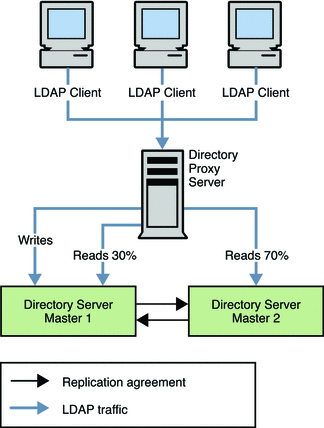Using Directory Proxy Server for Load Balancing
Directory Proxy Server can use multiple servers to distribute the load of a single source of data. Directory Proxy Server can also ensure that if one of the servers is unavailable, the data remains available. Apart from distributing data, Directory Proxy Server provides operation-based load balancing. That is, the server is able to route client operations to a specific Directory Server, based on the type of operation.
Directory Proxy Server supports operation-based load balancing, and a variety of load balancing algorithms that determine how the workload is shared between Directory Servers. For a detailed description of each of these algorithms, see Chapter 16, Directory Proxy Server Load Balancing and Client Affinity, in Sun Java System Directory Server Enterprise Edition 6.2 Reference.
The following figure illustrates how the proportional algorithm is used to balance read load across two servers. Operation-based load balancing routes all writes to Master 1, unless that server fails. On failure all reads and writes are routed to Master 2.
Figure 10–5 Using Proportional and Operation-Based Load Balancing in a Scaled Deployment

Note that the configuration for load balancing is not recalculated when one server instance fails. You cannot use proportional load balancing to create a “hot standby” server by setting a server's load balancing weight to 0.
Imagine, for example, you have three servers A, B, and C. Proportional load balancing has been configured such that servers A and B each receive 50% of the load. Server C is configured to have 0% of the load as it is designed to be a standby server only. If server A fails, 100% of the load will go to server B automatically. Only if server B also fails, will the load be distributed to server C. So, either the instance participates in load balancing all the time, always ready to take part of the load, or all primary instances have to fail before that server will take any load.
You can achieve something like a hot standby by using the saturation load balancing algorithm and applying a low weight to the standby server. Although the server is not a true standby server, you can configure the algorithm such that requests are distributed to this server only if the primary servers are under heavy load. Effectively if one primary server is disabled, the load on the other primary servers increases to the extent that requests must be distributed to the standby server.
- © 2010, Oracle Corporation and/or its affiliates
